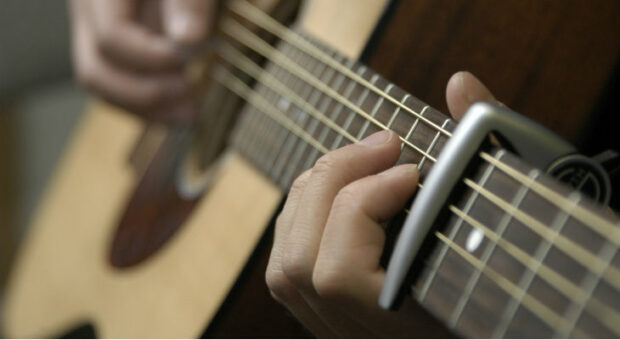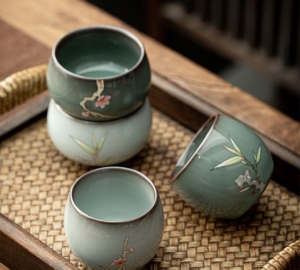The capo is an indispensable tool for guitar players who play in multiple keys in a single session. It is a tool that allows the musician to change the pitch of the strings without having to re-tune. Just put the capo on the desired fret and away you go. It’s as simple as that.

Choosing a capo might be the most difficult part of using one. Capos come in all sorts of styles. For example, the quick-change capo works like a clamp. You pinch the handles together to place the capo and remove it. As a side note, there is no functional difference between capos for electric guitars and those designed for acoustics. They all serve the same purpose.
Using a Capo to Raise the Key
The primary purpose of the capo is to raise the key in which the guitar player is playing. Each fret represents a half step in the scale. As such, placing a capo on the first fret would raise the key of C to C#. However, the musician does not play in C#. He still plays the chords in C. it is the capo that raises the key to C#.
It helps in this regard have a basic understanding of musical keys. To begin with, there are seven major keys corresponding with the seven notes of the C scale. There are additional minor, flat, and sharp keys as well. Familiarizing yourself with these keys can make it easier for you to determine where to place the capo on a song that is too low.
Avoiding Sharps and Flats
A capo can also be used to avoid having to play chords with sharps and flats. For example, the primary chords in the key of Ab major are Ab, Db, and Eb. These chords can be played as bar chords without a capo if you know what you’re doing. But if you don’t know how to play bar chords, you’re stuck. A capo solves the problem.
Because the capo raises the pitch of the strings by a half step per fret, you reduce the key of the chords you’re playing accordingly. Putting the capo on the first fret raises the pitch by half step, raising the key of Ab to A. But don’t play the chords in A or you will be too high. Instead, reduce the chord key by a half step. That means the Ab cord becomes a G. The Db becomes C and the Eb becomes D.
The rule of thumb for changing chords without changing keys is to reduce the key you are playing in by the same number of half steps you apply to the capo. Going up one fret is an increase of one half step. Decrease your chords by one half step. Putting the capo on the second fret raises the key by a full step. Lower your chords by a full step as well.
Create a Brighter Sound with the Capo
Another reason for using the capo is to create a brighter sound with your guitar. The higher you go up the fret board, the brighter the sound. This is a common tactic in folk music where multiple guitars are played simultaneously. One player will play open strings while the rest will use capos on different frets to create a more intricate blend of harmonies.
Easy Capo for Specific Chord Combinations
Some guitar players choose to use the capo because they want certain chord combinations in their songs. A good example is a song that includes Cmaj7, Fmaj7 and D2. These records are quite easy to play on open strings. They are more difficult to play as bar chords. Thus, you might choose to use a capo if you want to replicate the same sound you would get from playing the chords on open strings.
Similarly, you could transpose the song into a higher key to accommodate your vocal range. Imagine you transposed to E. Unfortunately, the Emaj7 and Amaj7 chords aren’t so easy to play on open strings. Moreover, they don’t sound as nice. Use your capo on the fourth fret to raise the key to E but still play the chords from C. You get the same rich tone by playing the original chords.
Putting a Capo in Place
Many guitar novices are unaware that capo placement is important. The capo should be placed as close to the right fret bar as possible without impeding finger movement. Your goal is to make sure that the strings are held firmly against that fret bar so that they don’t rattle. At the same time, putting it too close may inhibit your ability to play some chords.
It is okay to place the capo closer to the fret marker on the left as long as no other musicians are playing with you. If there are other musicians, placing the capo too far left will make your guitar sound slightly out of tune compared to the other instruments. That’s why the goal is to get the capo as far to the right as possible.
Your capo should also apply even tension across all six strings. Some capo styles are better at this than others. The quick-change capo, while convenient, is perhaps the least reliable in this regard. Quick-change capos also tend to lose their consistency over time. They wear out and don’t apply even pressure.
A better choice for consistent pressure is a trigger capo or an adjustable locking capo. Both types of capos physically lock in place to create even pressure across all six strings. The adjustable locking capo has a built-in screw adjustment for loosening or tightening the capo based on how far the strings are from the fret board.
The capo is an indispensable tool for guitar players. If you know how to use it, the capo makes changing the key you are playing in as simple as choosing the appropriate fret and putting the capo on it.



